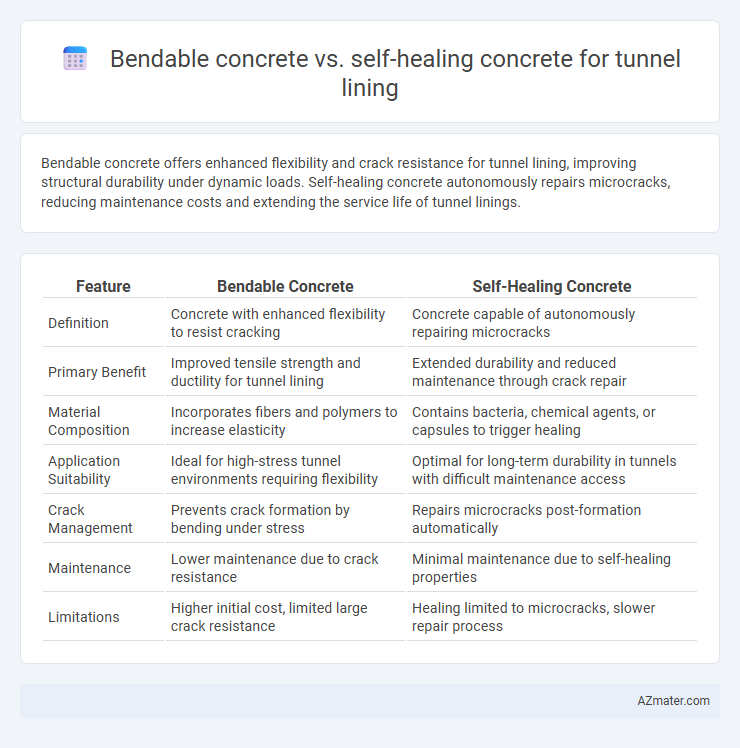Bendable concrete offers enhanced flexibility and crack resistance for tunnel lining, improving structural durability under dynamic loads. Self-healing concrete autonomously repairs microcracks, reducing maintenance costs and extending the service life of tunnel linings.
Table of Comparison
| Feature | Bendable Concrete | Self-Healing Concrete |
|---|---|---|
| Definition | Concrete with enhanced flexibility to resist cracking | Concrete capable of autonomously repairing microcracks |
| Primary Benefit | Improved tensile strength and ductility for tunnel lining | Extended durability and reduced maintenance through crack repair |
| Material Composition | Incorporates fibers and polymers to increase elasticity | Contains bacteria, chemical agents, or capsules to trigger healing |
| Application Suitability | Ideal for high-stress tunnel environments requiring flexibility | Optimal for long-term durability in tunnels with difficult maintenance access |
| Crack Management | Prevents crack formation by bending under stress | Repairs microcracks post-formation automatically |
| Maintenance | Lower maintenance due to crack resistance | Minimal maintenance due to self-healing properties |
| Limitations | Higher initial cost, limited large crack resistance | Healing limited to microcracks, slower repair process |
Introduction to Advanced Concrete Technologies in Tunnel Lining
Bendable concrete and self-healing concrete represent advanced solutions designed to enhance tunnel lining durability and performance. Bendable concrete incorporates engineered fibers and special admixtures to improve tensile strain capacity, allowing it to flex under stress without cracking. Self-healing concrete utilizes microcapsules or bacteria to autonomously repair microcracks, significantly extending the service life and reducing maintenance costs in tunnel infrastructures.
What Is Bendable Concrete?
Bendable concrete, also known as strain-hardening cementitious composite (SHCC), is an advanced material designed to withstand significant tensile deformation without cracking, making it ideal for tunnel lining subjected to bending stresses. It contains engineered fibers that enhance ductility and prevent brittle failure, ensuring improved durability and structural integrity in harsh underground environments. This innovative concrete can absorb and redistribute stresses more effectively than traditional or self-healing concrete, reducing maintenance needs and increasing tunnel lifespan.
What Is Self-Healing Concrete?
Self-healing concrete is an innovative material embedded with bacteria or chemical agents that activate upon crack formation to autonomously repair damage, enhancing durability and longevity. Unlike bendable concrete, which relies on flexibility to resist cracking, self-healing concrete chemically seals fissures, preventing water ingress and corrosion in tunnel linings. This functionality makes self-healing concrete a sustainable solution for reducing maintenance costs and improving structural integrity in underground infrastructure.
Material Composition and Structural Properties
Bendable concrete for tunnel lining incorporates engineered fibers such as polyvinyl alcohol (PVA) or steel fibers that enhance tensile strength and ductility, allowing the material to flex under stress without cracking. Self-healing concrete integrates microcapsules containing healing agents like epoxy or bacteria-based compounds that activate upon crack formation, enabling autonomous repair and prolonging durability. Structurally, bendable concrete provides superior energy absorption and crack resistance, whereas self-healing concrete excels in maintenance reduction by restoring microcracks, both improving tunnel lining longevity and safety.
Flexibility and Crack Resistance Comparison
Bendable concrete exhibits superior flexibility due to its engineered fiber reinforcement, allowing it to withstand significant tensile strain without fracturing, making it ideal for tunnel linings subjected to dynamic ground movements. Self-healing concrete, embedded with agents such as bacteria or microcapsules, enhances crack resistance by autonomously sealing micro-cracks, thus preventing water ingress and structural degradation over time. While bendable concrete prioritizes sustained flexibility to accommodate structural deformations, self-healing concrete focuses on maintaining integrity through autonomous repair, both contributing uniquely to tunnel lining durability.
Self-Repair Mechanisms and Durability
Self-healing concrete for tunnel lining incorporates microcapsules or bacteria that activate upon cracking, enabling autonomous repair and significantly extending the structure's lifespan. Bendable concrete emphasizes flexibility and strain-hardening properties to resist crack propagation but lacks intrinsic self-repair capabilities. The durability of self-healing concrete surpasses bendable concrete by continuously restoring integrity and preventing corrosion in harsh tunnel environments.
Installation and Maintenance Considerations
Bendable concrete offers enhanced flexibility for tunnel lining, reducing crack formation during ground movement and minimizing maintenance frequency, although its installation demands precise mixing and curing conditions to achieve optimal ductility. Self-healing concrete features embedded microcapsules or bacterial agents that autonomously seal cracks over time, significantly lowering maintenance interventions but requiring careful quality control during casting to ensure uniform distribution of healing components. Both materials aim to extend tunnel lifespan, with bendable concrete favoring resilience under deformation and self-healing concrete providing ongoing crack repair, influencing installation protocols and long-term upkeep strategies.
Cost Analysis and Economic Benefits
Bendable concrete offers significant cost savings in tunnel lining due to reduced maintenance and repair expenses, as its high ductility minimizes crack propagation under stress. Self-healing concrete, while generally more expensive upfront because of specialized additives like microcapsules or bacteria, extends tunnel lifespan by enabling autonomous crack repair, lowering long-term rehabilitation costs. Economic benefits of bendable concrete arise from improved durability and reduced lifecycle costs, whereas self-healing concrete's value lies in decreased downtime and enhanced structural integrity over time.
Environmental Impact and Sustainability Factors
Bendable concrete in tunnel lining offers enhanced durability and crack resistance, reducing maintenance frequency and resource consumption over the structure's lifespan. Self-healing concrete incorporates bacteria or chemical agents that autonomously repair micro-cracks, significantly extending service life and minimizing material waste and carbon emissions related to repairs. Both technologies contribute to sustainability by lowering environmental impacts, with bendable concrete emphasizing structural resilience and self-healing concrete focusing on lifecycle longevity and reduced repair interventions.
Choosing the Right Concrete for Tunnel Lining Applications
Bendable concrete offers enhanced tensile strength and flexibility, reducing cracking risks during tunnel lining deformation, while self-healing concrete autonomously repairs microcracks, extending service life and minimizing maintenance. Tunnel lining applications benefit from bendable concrete in areas prone to dynamic loads or ground shifts, whereas self-healing concrete is ideal for environments with frequent moisture exposure and durability challenges. Selecting the right concrete depends on site-specific stress conditions, expected crack development, and long-term maintenance strategies to optimize structural integrity and lifespan.

Infographic: Bendable concrete vs Self-healing concrete for Tunnel lining
 azmater.com
azmater.com